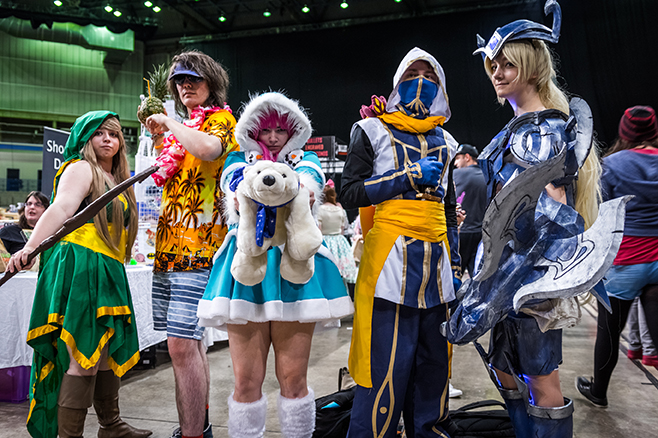When parents, friends and family set out to buy art supplies for the children in their lives, the usual priorities come into play: safety, price point, age appropriateness and durability. But how do parents know what supplies their kids will like? Are they reading mommy blogs? Clicking on Instagram ads? Listening to relatives? Hitting aisle 4 of the dollar store and calling it a day? Now that we’ve expanded our collection of children’s art supplies and added activities, kits and gifts to the mix, you and your staff are probably brainstorming how to reach parents, aunties, grandparents and the occasional fairy god-mother. To learn more about what parents and kids want and need from art supplies, we reached out to a unique demographic: MacPherson’s moms, dads, aunties and uncles.
MacPherson’s parents certainly don’t speak for the average parent; they have a bit more experience with art supplies than most. They do however offer perspectives of parents who have gone out on a limb. They have tried new or more pricey products and observed how specific items keep their child’s attention, improve motor skills and build confidence. Many of them have also thought a lot about the supplies we carry. Their role might involve researching, describing, pulling or picking, photographing, testing, cataloguing or curating these items. This knowledge-base in conjunction with their experience as Mac parents provides plenty of insight for you and your team to use as talking points to help connect customers with products their kids will love.
We encourage you to learn from parents, aunts and uncles on your team and in your community as well; you’ll discover what they need and want as well as how external influences, like education or art background, impact their relationship with art supplies. While you can’t shape those influences (unless you offer classes, have kid-centered events, etc.), investigating allows you and your staff to chat candidly with parents and other adults who are shopping for kids and help them choose products that will keep their kids engaged.
Special thanks to Assistant Category Manager Daisy Madieros, Category Manager Lacey Elia, Graphic Designer Tali Even-Kesef, Customer Service Manager Rudy Gomez, E-Commerce Manager Gina Farias and Digital Asset Manager Iqvinder Singh.
Micador early stART No Drip Paint & Bubblegum Brushes, designed for little hands
Early Hits
Laying the foundation for a successful children’s section means thinking about multiple stages in a child’s development. While tots are just starting to explore texture and color, Google-savvy elementary aged children want to show off their finished projects with pride. We’ve divided this series into three parts: early childhood, elementary aged children and teens. For now, we’ll be focusing on children ages 1 – 4.
For the under 5 crowd, the messier (and more washable) the better. Playdough and big, fat crayons are king. Category Manager Lacey Elia mentions that her son’s experience at a play-based preschool influences how he approaches creative materials. “They paint on the cement with water when it’s hot outside, they mix color in with shaving cream. Glitter is everywhere. They use washable paint or chalk on the fences outside,” she mentions. Color-mixing is a big deal. “I remember when Simon was 2 or 3, painting on an easel,” Graphic Designer Tali Even-Kesef says, “He put the blue on and then the yellow. When they made green, he turned to the camera amazed, like, What is this!? For kids, art supplies are magic when they are good. It encourages different kinds of creative outlets. They may not grow up to be artists—though my youngest says he will—but at least they can appreciate it.”
How to merchandise these items? Create an in-store messy station or host a monthly kid-friendly event. Show parents what the products can do, make space for tots to try them out and educate your staff on the features of specific products, such as the Micador early stART line, which helps very young children develop their fine motor skills. Create signage emphasizing details like this, especially around the holidays when relatives will be browsing for a range of gifts for the entire family.

Game Changers
A few products worth spotlighting:
- STABILO Woody 3 in 1. These are a long-lasting product parents won’t regret purchasing. “My four year old daughter uses them as watercolors. She also writes on the walls in the shower to practice her name, shapes, and ABC’s,” E-Commerce Manager Gina Farias says. “Both my kids (5 and 11) really like the STABILO Woody because they can draw on the windows,” Tali says. “Products that are built to last are important. Kids are not gentle! Yes, it can be more expensive, but Woody’s will last you three or four times longer than the cheaper stuff.”
- Faber-Castell Gel Crayon Set. “My daughter loves the gel crayon set, the colors are vibrant and smooth,” Lacey says. “There is the added value that you have to twist them to push them out and when you are done, to put them away,” she adds. “The product develops those fine motor skills.”
- STABILO Scribbi. “Scribbis are designed so the tip goes in when the kids push on it super hard,” Lacey explains. “They have to learn how to use it, and they figure out how to color, how to go lighter. That kind of stuff I would splurge on.” The Scribbi is not only juicy and fun to use, it increases the likelihood that in the near future other markers will survive children’s creative verve as well.
- Micador No-Drip Paint. “The colors are brighter than other paints,” Gina says. “And it doesn’t spill everywhere: if it tips over, it says in the jar. When it’s on the brush, if shes she’s being rough with it, it doesn’t splatter and spray everywhere. Very mom-friendly.”
Check in with your staff, especially people with children or young nieces and nephews. What products would they spotlight? Write up a staff recommendation, similar to book recommendations in bookstores. Include the name and age of the kiddo who loves the product and a brief description of why they love it and what they like to make with it! This will inspire customers and help them imagine what the product can do.

Cheap, Not Cheery
Most of the time, buying the cheapest supply for a two year old is completely understandable; this may be the priority for most parents. But there are some important takeaways from the experiences the cheapest item on the shelf creates. Make sure your staff know to mention the specific perks of the premium products! The parents on our team pointed out some pain points.
The boulevard of broken crayons. A downside to economical kids’ art supplies! Once crayons break, they tend to be ignored and left at the bottom of the bin. Real talk: “The regular person might not recognize it, but once you use nicer crayons you can tell,” Lacey says. “Their color is vibrant, lasts forever and the crayons don’t break. With cheap dollar store crayons, the colors aren’t as accurate, they are skinny and brittle…. I don’t know if I would only buy the Faber, but if my kids are really into a specific project I will splurge on something nice.” “I have a lot of broken crayons at home,” Daisy adds. “I wanted to bring them to a reuse center, we just have so many. My kids like to use STABILO Woody best, they can mix watercolor with them. They last forever.”
The notoriously skimpy brush that comes with the paint set. “That brush pisses me off!” Tali says, heated (you can tell when a parent has an art background, just saying). “They aren’t even brushes, they are just plastic bristles! The colors of the paint might be fine, but you are giving kids a terrible experience with watercolors with that brush. If it’s not hard bristly plastic, it has hair that comes out in their art. Kids get frustrated. I will pull out a few nice brushes and let them use those. Kids care…they notice the difference.”
The color quality. It’s the same for grown up art supplies: the more expensive, the brighter and more vibrant the color. Digital Asset Manager Iqvinder Singh notes that when he gets his kids paints that are a bit nicer, he “can clearly see the quality and vibrancy in their work when it’s hanging in their school next to other kids’ work.”
(Not) keeping their attention. “When I bring home nicer stuff, it keeps their attention more,” Customer Service Manager Rudy Gomez notes. Dollar store buys “might be a quick play through, then it’s trashed.”
These are concrete examples of why people should invest in decent art products. Share these examples with a sales associate and try to brainstorm a few more with people who have young children in their life. Having this knowledge on hand will allow your team to help customers bring home better art supplies and have more varied creative experiences with their children!

Retailers getting acquainted with Woody 3-in-1s at Dealer Workshop.
See It To Believe It
Kids and parents need to see art supplies in action to get drawn in. Rudy gets inspired to try new things with his kids when he attends Dealer Workshop, or when he sees what our community of retailers are up to. “When I see customers making something, or go to trade shows, I want to try it out with my kids. That’s how I found out about paint pouring, slime and Chameleon colors,” Rudy points out. While parents need to see it to believe it, kids are the ones typically vocal about what they want. “If I take my daughter to a craft store and she shows interest in something, I’ll grab it,” Lacey says. “The less expensive version at first,” she clarifies.
If a messy station or product testing area is not doable in your space, have an event, take pictures of kids using different products, with big smiles on their faces (with permission of course). Print those pictures out and create an interactive photo album with products and visuals. It sounds cheesy but seeing kids having fun or engaged and focused with specific products that are new to browsing parents will help them make the connection and invest in the item.

Wish List
If parents could invent art supplies to meet their kids’ unique needs what would they create? We asked parents what they wished existed for their kids. Their answers can help guide the art supply community; we can take inspiration from their observations and present parents with the best possible options.
“Washable paint that’s bright!”
“Super strong tape that’s easy to dispense and safe for kids.”
“Unicorns. Anything with unicorns.”
“A silk-screening kit for kids but without all the mess involved in burning screens.”
We found this exercise inspiring for our own purpose too; we will continue to search for products like this on everyone’s behalf!
Part Two
Next stop? Kids and tweens! Post-kindergarten, kids’ interests get a bit more sophisticated. Stay tuned for part two of this series about elementary-aged kiddos, the kind of art they like to make and the products they love.







2 Comments
JoAnn Brown
Great information that I will pass along to staff so that they can “sell the good art supplies better”. Look forward to other articles.
Catherine Monahon, Copywriter • MacPherson's
JoAnn, I’d glad you found this useful and I hope your staff enjoys it as well. We post every week so be sure the check back soon!